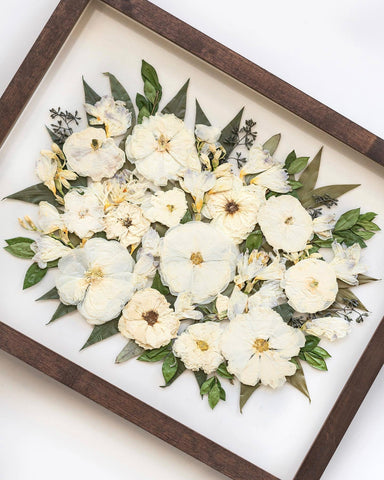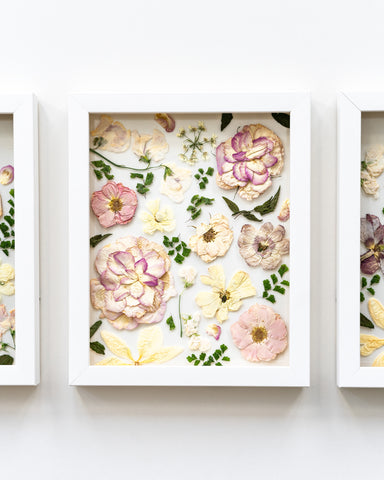What if I Have an All-White Bouquet?
A wedding bouquet is so sentimental, and here at Pressed Floral we preserve your bouquet so that you can admire it forever! However, there are some things to be aware of before you decide to preserve your bouquet. We love to work with all different types of bouquets and we love seeing a bride’s personality shine through their sentimental floral design! A lot of brides are traditional and love a white bouquet to match their white dress. Here are some things to keep in mind if you choose to have an all-white bouquet while still wanting to preserve your florals.
Colored Florals
At Pressed Floral, we do prefer colored bouquets. This is because they preserve better as they retain color and don’t brown, though they will start to fade over time as any flower will. Colorful florals are often easier to work with. This is because the colors are eye-catching, show dimension, and express personality. Colors tend to provide a better-finished product after preservation, as white blooms don’t stay bright white. A bouquet with all of the same color blooms can also blend into each other. When there are different colors, it can be easy to see which flower is which, even from a distance. This creates dimension in your frame and elevates the overall look. Again, white bouquets are undoubtedly beautiful, it’s just a matter of preference. Because colorful blooms are easier to work with, some floral preservationists won’t accept bouquets if they are all white. Some won’t even accept bouquets with more than 20% white flowers. We want to provide anyone who wants to work with us with a gorgeous and timeless work of art for their home. That includes brides who have an all or primarily white bouquet. We hope to educate on why they wouldn’t be accepted, white flowers and bouquets are more difficult to work with for the following reasons.
Here are some things to keep in mind if you’re set on an all-white bouquet while still wanting a custom frame from us. First, every white flower dries in a different shade. Some preserve more yellow, some more ivory, and some more brown. This means that while your bouquet was all white/one color, your frame most likely won’t be. This can be disconcerting to some as the design might not match their neutral decor. We suggest purchasing a walnut brown, sleek black, or natural wood frame instead of a solid white one if you have an all-white bouquet for this reason. A white frame tends to accentuate the fact that the once-white blooms are now more yellow, ivory, or brown. Make sure you take a look at these photos to fully understand what different shades of white would look like in a frame.



The second thing to be aware of is that white flowers will brown 95% of the time. While we do everything in our power to minimize browning, it is natural. Even fresh, bright white flowers will brown slightly. The biggest problem arises when the flower is starting to die from the stem. The browning will spread from the center and be much darker than a fresh flower. However, in the long run, all white flowers will not look as bright, no matter how fresh they are when we press them. The reality is that all preserved flowers continue to change over time.



So what can you do to minimize brown flowers in your frame? The first and most important thing is to get your flowers to us ASAP. The sooner we get the blooms, the less time they have to start browning from the stem. While all white flowers will turn some shade of brown, they are much less likely to turn completely brown if we press them before they start to deteriorate. Once the flowers start to mold or rot, they are exponentially more likely to brown, and the browning will be worse than a fresh flower.
We ask that you take a very close look at our shipping instructions to get your blooms to us in the best possible condition. If the flowers are packaged in plastic, it may not matter how quickly you get your blooms to us as plastic traps moisture and will accelerate the wilting process. The flowers may also be more prone to browning if they are squished or flattened while in the box. We recommend shipping your blooms by surrounding them in paper or packing peanuts. Continue by covering the stems in a wet towel covered by a plastic bag to hold moisture on only the stems.
If you receive the approval photo of your design and see that your white roses/flowers are browner than you expected them to be, we are happy to replace them with brighter flowers from our inventory at your request. However, if you decide to go this route, please remember that these flowers are not the actual flowers from your bouquet. We will be sure to communicate this and make sure that you would like to switch out your flowers with our inventory before making any changes to your frame. It’s important to remember that while the flowers from our inventory are whiter than your original flowers, they will still naturally dull over time.
When choosing florals, many people overlook filler flowers and greenery. They are crucial in allowing your frame to look more “full” by giving it more movement and intrigue. Filler flowers are small flowers that cover gaps and blank spaces in a bouquet without adding any bulk to it. They also act as an effective accent to the bigger flowers. Some filler flowers we love working with are Baby’s Breath, queen anne’s lace, veronicas, chamomile, and amaranthus. Wax flowers are pretty, but not our favorite as we can’t press them open, so they don’t look as cute in a frame. We love when bouquets come with greenery as it creates layers to your piece in order for your flowers to be seen as the main event. Greenery can create a three-dimensional aspect of your pressed flowers. It also helps with the contrast of small, detailed filler flowers. If you want your bouquet to be truly all-white, we recommend bleached greenery. Greenery that has been bleached is a perfect addition as it won’t brown during the preservation process. Some greenery that is gorgeous when bleached is italian ruscus, ferns, and bunny tails.
The most popular white flower that doesn’t preserve well is the white rose. We absolutely love roses! However, not all roses are created equal. All white roses will brown during the preservation process, even just a little, and will continue to slightly dull over time. But all hope is not lost! There are species of roses we have found throughout our process which press better than others. We have also found that the hardest rose to press is Juliet garden roses and other similar species. Unfortunately, these roses tend to brown quickly and more than any other. They are also much harder to work with as their petals lay right on top of each other instead of in a spiral pattern like other roses. Because of this, we advise you to pick different roses rather than these garden roses. If you love the look of these garden roses and want them in your bouquet, we ask that you either include other roses in the bouquet or send us other roses to press. We ask this because garden roses brown much easier.


So what should your bouquet look like to have the best possible floral preservation experience? The type of flowers in your bouquet is key! There are white flowers that press beautifully, and others… not so much. Some white flowers that are beautiful when pressed include larkspur, ranunculus (especially butterfly), and sweet peas. The white flowers that don’t look very pretty when pressed are snapdragons, chrysanthemums, and anthurium. Lisianthus’ are pretty when pressed, but they tend to turn much more yellow than people would expect or prefer. We can still work with these flowers that don’t press as well, but it’s important for you to understand what they look like when they are pressed. There are some flowers that only press depending on their condition. If we get them fresh and in good condition. They will press well. If the specific species are dying, they do not. These species of flowers include hydrangeas, stock flowers, and roses. That is to say, all flowers will press better if they are in good condition. So again, it is important to get them to us as soon as possible after your event. Please remember to package them properly by referencing our shipping instructions. We recommend shipping to us through UPS with overnight shipping the morning after your event.
While we do prefer colorful bouquets, it is not a requirement to work with us! Just keep in mind that white flowers will brown over time, press in different shades, and will not look as bright. In order to reduce browning, getting your flowers to us quickly and correctly is important, but we can also switch out your flowers with our inventory at your request. If you are considering white roses in your bouquet and fear that they may not press well, please reach out to our team for rose species recommendations. Finally, remember to choose a variety of flowers that press well in your white bouquet. We can’t wait to design a gorgeous frame for you!
